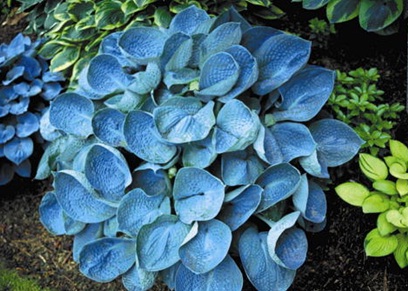Categories
Calendars
Guides
Reviews
Archive
Gallery
Articles
Ask Our Gardening Expert
Hosta
They grow from rhizomes and originally grown as ground cover but are also excellent in pots and containers, making them ideal for small gardens. Their leaves come in a range of shapes, sizes and colours, variegated or solid colour. The plants need little maintenance, they are easy to grow, tolerate shade and come in over 2000 varieties.
Hosta “Love Pat”
The natural leaf colour of the wild species is green, though some have a waxy coating that gives it a blue tinge. Mutations of native species have yellow green leaves or with white or yellow edges or centres. Hostas produce white to lavender flowers in summer and are being bred to produce larger and more attractive blooms. Fragrant flowers are hybridised from Hosta plantaginea which has blooms 150mm long.
A mixed planting used as ground cover
Slugs and snails are the only real pest, though rabbits and deer will graze them if they are present.
Hostas are herbaceous perennials grown for their foliage. They are relatives of the asparagus and a native of China, Japan and Korea. Parts of them are even edible. 
Although shade tolerant, they do not tolerate deep shade. They grow best when exposed to morning and evening sun. The blue leaved hostas do better in shade while the gold/yellow/white cultivars tolerate more sun. Fragrant hostas need 5-6 hours of daily sun for the blooms to develop.
Hostas prefer humus rich, well drained, pH neutral soil. Dig the planting hole 30cm deep and about one and a half times wider than the clump. Most roots spread horizontally, so a wide hole is better. Remove the plant from its container and if well rooted, make vertical cuts in the root ball. Place the plant at the same level in the hole as in the container and water well. A balanced fertiliser applied each spring will be enough. Propagation is by division. Hostas can be used to good effect either as small, mixed plantings or as a mass of one cultivar.